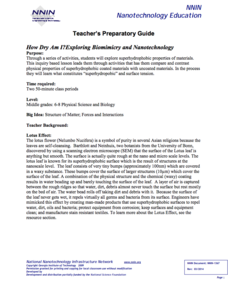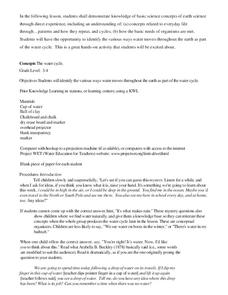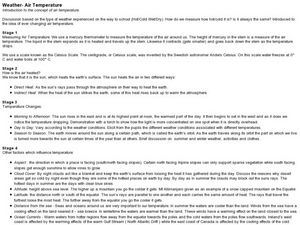Curated OER
Dripping Wet or Dry as a Bone?
Students use a sponge and water model to explore the concept of relative humidity and create a percent scale. They define humidity and saturation, build a simple humidity/saturation model, collect, predict and interpret data, and create...
National Nanotechnology Infrastructure Network
How Dry am I? Exploring Biomimicry and Nanotechnology
Help your classes feel like they can walk on water! An engaging inquiry-based lesson has young scholars experiment with different surface coatings. They make observations about their properties and how they relate to the surface tension...
Curated OER
Science Discovery Lesson: Air is All Around Us
Students explore the concept that air is everywhere. They assess that it can't be seen, but is all around us. Each student becomes aware that air takes up space and listen to the book, "Air is All Around You," by Franklin M. Branley.
Curated OER
Sow Bug Habitats
Students conduct an experiment to determine what type of environment sow bugs prefer. They use petri dishes with partially wet paper towels to assess whether they prefer wet or dry habitats.
Curated OER
What is Drawing?
Learners explore visual arts by participating in a drawing activity. In this artistic expression activity, students discuss how our thoughts and emotions are conceptualized by illustrating or painting. Learners utilize charcoal, pastels,...
Curated OER
Waterproof Paper
Learners explore matter through the concept of displacement. They perforrm an inquiry experiment with a glass, paper and a bucket to demonstrate that gases take up space.
Curated OER
The Mystery of the Sponge
First graders observe while water is absorbed into a sponge. They experiment by putting a sponge on yardstick and watch while water dries and the weight changes.
Curated OER
Nature Walk
Students participate in a mini field trip around the neighborhood to observe nature and changes that are occurring during fall. They collect leaves of various colors, shapes and sizes on their trip. Upon return to the classroom, they...
Curated OER
Watercolor Techniques
Students practice using watercolor paints in this lesson. They observe basic techniques used with watercolors and then try them. They use the internet to discover more techniques they could use.
Curated OER
Preventing Hypothermia
Students identify the causes of hypothermia. In this biology lesson, students investigate the different types of heat transfer and heat loss. They discuss several practical measures to avoid hypothermia.
Curated OER
Soil's Secret
Students examine two types of soils in their area. They identify its texture and permeability to determine its origin. They share their results with the class.
Curated OER
Weather
Fifth graders study the water cycle. In this science lesson plan, 5th graders distinguish among evaporation, condensation, and precipitation phases of the water cycle.
Curated OER
Mathematics Within: Algebraic Patterns
Students comprehend that ratios and fractions are interchangeable. They compare ratios using common denominators, cross multiplication, and intuition. Students find equivalent fractions. They comprehend that equivalent ratios do not...
Curated OER
The Water Cycle
Students access prior knowledge of the water cycle by completing a KWL. In this water cycle lesson, students follow the movement of water through the water cycle.
Curated OER
Drawing From Nature
Students observe similarities and differences of natural objects. In this observation instructional activity, students use a magnifying glass to identify the details of objects.
Curated OER
Methods of Heat Transfer
Eighth graders discuss the forms of heat transfer that relate to the human body. Discussion revolves around the ability of different designs of hats to change the rate of heat transfer to and from the body. Students then experiment...
Curated OER
Weather-Air Temperature
Students complete activities to learn about changing air temperature. In this air temperature lesson, students study various ways to measure air temperature and learn factors that influence temperature. Students study the weather in a...
Curated OER
The Bounty of Bernoulli
Learners explain how Bernoulli's principle apply to some phenomena. In this physics lesson, students draw and explain the demonstrations shown in class. They research and design their own demo on Bernoulli's principle.
Curated OER
Build Your Own Sling Psychrometer
Students construct a sling psychrometer and they measure the relative amount of humidity in the air. They create their own experiment on how to construct a sling psychrometer and how they are going to measure the relative humidity in the...
Curated OER
What's In the Dirt?
Third graders watch a demonstration and write in their journals their predictions about how time might affect the moisture in the two paper towels. Using a Berlese funnel, they record their observations when it comes the amount of...
Curated OER
Variables
Learners watch a video show how to identify the independent variable, dependent variable and controls in an experiment; and design experiments that use controls to isolate a single independent variable and measure the resulting dependent...
Curated OER
Transformation of Energy
Sixth graders explore and discuss how several electrical devices work and what energy conversions occur in each device. They connect a zinc strip to a copper strip with alligator clips and wire, immersing each strip in lemon and check...























